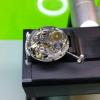-
Recently Browsing
- No registered users viewing this page.
-
Topics
-
Posts
-
VWatchie, I remember you saying you have picked up a few bargains on that site.
-
Your original balance can be poised by adjusting the balance screws. The replacement can't and it is cheaper to make.
-
OK, let me try and expand on why I think this is right (but maybe misleading at the same time). Wikipedia has a good explanation of surface tension, which is where I got most of the ideas below. The cohesion of the liquid molecules binds them together into the most compact form possible. If there are no external forces acting, this is a sphere. Surface tension is the combined effect of the cohesion between molecules on the surface with others on the surface, as well as the cohesion to molecules just under the surface, causing contraction and the formation of a denser "skin". The way a droplet of a liquid forms on a solid surface is determined by the strength of this cohesive force relative to the adhesive force between the liquid molecules and the surface material. If cohesion >> adhesion, you get a droplet. If cohesion is similar to adhesion, the liquid tends to spread out on the surface and creep away from its original location. Oil doesn't have the same high surface tension that water does, so it is not going to form a really rounded droplet on any surface in the way that water will "bead" on wax. This is where my earlier statement is misleading, but it is still exactly the same principles at work. Drops of oil on an epilamed surface are not going to run off in all directions at the lightest provocation. What the epilame does, I think, is reduce the adhesive force to the surface somewhat, making the weak cohesive force of the oil molecules more effective. The result is less tendency of the oil to spread out and creep, and more tendency to stick together as a cohesive mass. I don't think epilame has any effect on surface tension. That is a property of the liquid and is determined solely by the cohesive forces between the liquid molecules. I also don't think the epilame makes the liquid "stick" to where it is applied. The oil adheres ("sticks") more strongly to a non-treated surface than to a surface treated with epilame. This is why the epilame needs to be removed from the contact surfaces by running dry for a short period. The oil then sticks more readily to the local contact surfaces, where the epilame layer is worn away, than to the surrounding area. The oil sticks together, and is thereby anchored in place as a single body. Interestingly, reducing the adhesion of the oil to the solid surfaces will also reduce capillary action, which is what we rely on if we don't use epilame. Another reason to make sure the epilame is worn away from the spot you want the oil to stay put.
-
By RichardHarris123 · Posted
Look up index vs free sprung balances. The screws are for timing.
-









Recommended Posts
Join the conversation
You can post now and register later. If you have an account, sign in now to post with your account.
Note: Your post will require moderator approval before it will be visible.